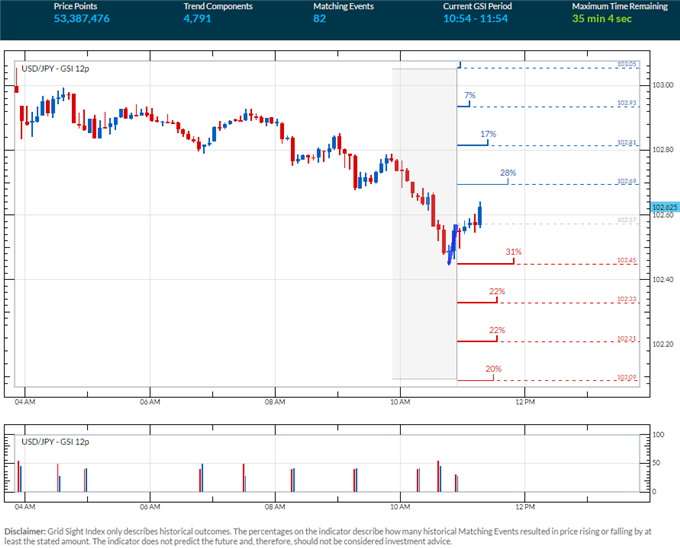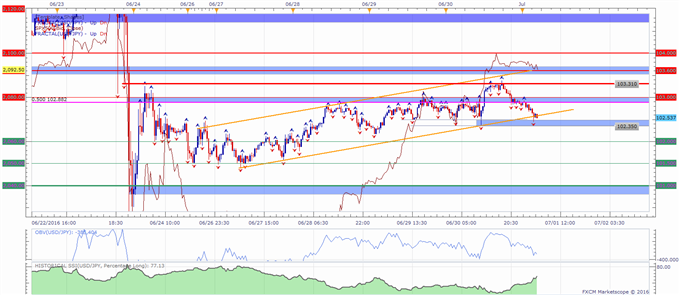Talking Points:
- USD/JPY trading lower alongside SPX 500 as we head into a possible low liquidity couple of trading days
- US ISM Manufacturing figures headline the economic calendar, but might have reduced short term impact
The USD/JPY is edging slightly lower to start the last trading day of the week after correcting more than 50% of its “Brexit” decline. The pair saw a significant drop following the referendum, as the market turned to safety and boosted the Japanese Yen versus the US Dollar.
This weekend is a holiday in the United States with the 4th of July on Monday that might imply lower liquidity in the next couple of trading days, possibly making for more difficult trading conditions.
US ISM Manufacturing figures headline the economic calendar, but might have reduced short term impact as it seems economic indicators took the back seat lately for more prominent themes such as “Brexit” related news.
Taking this into consideration, we look to find short term trading opportunities using the Grid Sight Index (GSI) indicator.

Click Here for the DailyFX Calendar
The US ISM Manufacturing figure is the main economic indicator on the docket today. The June Survey is expected to print an unchanged figure at 51.3. The number could provide significant price swings at certain times, which calls for caution around the release (and even more so with possible messy trading conditions), but it seems like economic indicators short term impact has been reduced lately since outcomes have yet to reflect a post-Brexit picture. This leaves “risk trends” in the spotlight to possibly guide the pair as we approach the final hours of the trading week.
USD/JPY 5-Min GSI Chart: July 1, 2016

The USD/JPY is seeing a slight bounce off the 102.50 support (see chart below). The GSI indicator above shows a generally even distribution to the topside or the downside in which similar past momentum patterns have unfolded. The GSI indicator calculates the distribution of past event outcomes given certain momentum patterns, and can give you a look at the market in a way that's never been possible before, analyzing millions of historical prices in real time. By matching events in the past, GSI describes how often the price moved in a certain direction.
You can learn more about the GSI here.
USD/JPY Technical Levels:

Click here for the DailyFX Support & Resistance tool
We use volatility measures as a way to better fit our strategy to market conditions. The current “quiet” period in the pair as opposed to higher probabilities of volatile reactions because of the “Brexit” situations might make for ripe condition for significant price swings should a catalyst present itself, and even more so in the next couple of trading days on possibly lower liquidity. This could imply that break out type trades are preferable in the short term.
USD/JPY 30-Min Chart with SPX 500 Overlay: July 1, 2016

The USD/JPY is attempting a break below a rising channel trend line after seeing a slight bounce from a support area between 102.50 to 102.35. Levels of interest on a push lower appear to be technically clear at the 102 handle, followed by the 101.50 figure and a possible support zone below the 101 handle.
Level of interest on a move higher could be a potential resistance area slightly below the 103 handle followed by the 103.310 level and a resistance zone around the 103.60 level. The 104 handle lurks above.
When price reaches those levels, short term traders might use the GSI to view how prices reacted in the past given a certain momentum pattern, and see the distribution of historical outcomes in which the price reversed or continued in the same direction. We generally want to see GSI with the historical patterns significantly shifted in one direction, which could potentially be used with a pre-determined bias as well.
A common way to use GSI is to help you fade tops and bottoms, and trade breakouts. That’s why traders may want to use the GSI indicator when price reaches those specific pre-determined levels, and fit a strategy that can offer a proper way to define risk. We studied over 43 million real trades and found that traders who do that were three times more likely to turn a profit. Read more on the “Traits of Successful Traders” research.
Meanwhile, the DailyFX Speculative Sentiment Index (SSI) is showing that about 77.1% of traders are long the USD/JPY at the time of writing, and have been on the wrong side for a significant period of time. In turn, this could suggest further weakness ahead for the pair (See the “Traits of Successful Traders” research).
You can find more info about the DailyFX SSI indicator here
--- Written by Oded Shimoni, Junior Currency Analyst for DailyFX.com







